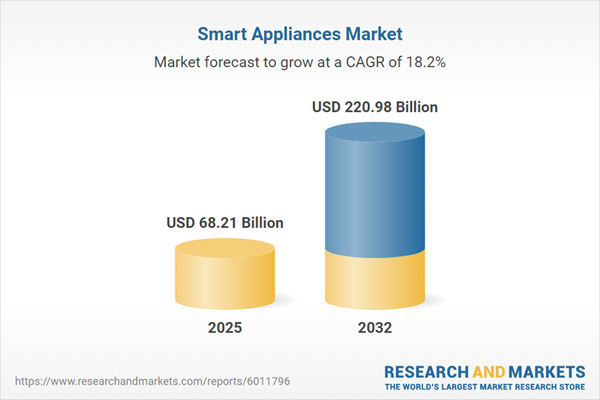Speak directly to the analyst to clarify any post sales queries you may have.
Senior decision-makers navigating transformative business environments are increasingly leveraging smart appliances as critical enablers of operational efficiency, resilience, and process innovation. As these devices integrate seamlessly into commercial and institutional workflows, they deliver measurable value by optimizing energy use, supporting sustainability commitments, and improving user experience across diverse sectors.
Market Snapshot: Smart Appliances Market Size and Growth Drivers
The global smart appliances market stands at USD 58.10 billion and is set to reach USD 68.21 billion within the next year. With a compound annual growth rate of 18.17%, total revenue is forecast to reach USD 220.98 billion by 2032. Growth is fueled by advancements in artificial intelligence, machine learning, and sensor automation. These innovations enable smart appliances to offer intelligent voice control and enhanced connectivity, allowing organizations to streamline changing processes and meet new operational objectives. As adoption expands, smart appliances are now strategic investments for forward-thinking enterprises seeking infrastructure that adapts to modern expectations.
Scope & Segmentation of the Smart Appliances Market
- Appliance Types: The portfolio includes air conditioners, refrigerators, ovens, vacuum cleaners, washing machines, microwaves, dishwashers, coffee makers, lighting systems, fans, heaters, blenders, cooktops, toasters, as well as wellness and productivity devices. Diverse options ensure tailored solutions for commercial and institutional applications, meeting both routine and specialized facility management needs.
- Technologies: Artificial intelligence streamlines decision-making. The Internet of Things provides integrated device communication, and sensor networks deliver real-time operational insights. Enhanced voice control supports intuitive use and accessibility in fast-paced environments.
- Connectivity: Organizations choose between wired infrastructures for robust performance and wireless options that facilitate flexible deployment and remote monitoring. Both approaches support scalable expansion and integration across sites.
- Energy Sources: Battery-powered, electric, and solar-compatible models offer organizations the ability to align purchasing with sustainability goals, mobility needs, or regulatory mandates regarding energy use and environmental impact.
- End Users: Healthcare, hospitality, office, and retail sectors leverage smart appliances for greater compliance, safety, and improved process efficiency. Residential demand increasingly reflects preferences for automation and convenience that reduce manual intervention.
- Distribution Channels: A combination of traditional retail and digital platforms supports regionally flexible procurement strategies and meets varied sourcing requirements.
- Regions & Key Sub-markets: The Americas, Europe, Middle East & Africa, and Asia-Pacific each show distinct regulatory climates and design priorities. Regional differences influence adoption timing and competitiveness, encouraging localized product and go-to-market strategies.
- Company Coverage: Industry participants such as Dyson Direct, Electrolux, Haier Group, LG Electronics, Midea Group, Honeywell, Siemens AG, Samsung Electronics, Whirlpool, and Xiaomi, as well as newer entrants, are advancing innovation and adapting business models in response to shifting market expectations.
Key Takeaways for Senior Decision-Makers
- Flexible control solutions increase agility for distributed and remote teams, expanding user access and supporting evolving workplace models.
- Transitioning to subscription-based or managed service offerings increases engagement and ensures consistent business operations even during market disruptions.
- Modular design principles promote rapid deployment and make it easier to adapt to evolving sector demands and regulatory changes.
- Collaboration with telecom and cloud providers enhances multi-location device management, delivering higher operational transparency and scalability.
- Staying closely aligned with emerging regulatory requirements and regional preferences maintains market relevance and supports ongoing compliance.
- Heightened cybersecurity is vital to safeguard organizational data as device connectivity and integration become more widespread.
Tariff Impact
New tariffs on U.S. smart appliance components have increased production costs, prompting supply chain and procurement leaders to reevaluate sourcing and expand local manufacturing. These adaptations, while initially compressing profit margins, are ultimately building more resilient and transparent supply chains. Communicating price adjustments strategically is helping to sustain customer confidence and limit business disruption.
Methodology & Data Sources
This report is based on interviews with senior executives, thorough end-user surveys, and expert input from technology leaders. Proprietary analytics are triangulated with secondary research and company disclosures to validate all findings and support sound decision-making.
Smart Appliances Market: Why This Report Matters
- Empowers executives to design agile, future-ready product strategies that address ongoing regulatory and technology shifts in the smart appliances sector.
- Supports adaptive supply chain practices, equipping leaders to navigate compliance challenges and dynamic market conditions effectively.
- Delivers precise segmentation and actionable insights for improved strategic decisions and sustained competitive advantage.
Conclusion
Investing in smart appliances equips organizations to drive operational improvements and maximize stakeholder value. Continued innovation and strategic sourcing will support future progress and long-term market success.
Additional Product Information:
- Purchase of this report includes 1 year online access with quarterly updates.
- This report can be updated on request. Please contact our Customer Experience team using the Ask a Question widget on our website.
Table of Contents
3. Executive Summary
4. Market Overview
7. Cumulative Impact of Artificial Intelligence 2025
Companies Mentioned
The companies profiled in this Smart Appliances market report include:- Dyson Direct Inc.
- Electrolux AB
- Godrej Enterprises Group
- Gree Electric Appliances Inc. of Zhuhai
- Haier Group Corporation
- Honeywell International Inc.
- Huawei Technologies Co., Ltd.
- Koninklijke Philips N.V.
- LG Electronics U.S.A. Inc.
- Midea Group Co., Ltd.
- Miele & Cie. KG
- Netatmo S.A.
- Panasonic Corporation
- Rinnai Corporation
- Robert Bosch GmbH
- Samsung Electronics Co., Ltd.
- Siemens AG
- Sony Corporation
- V-ZUG Ltd.
- Vestel Ticaret A.Ş
- Voltas Limited
- Whirlpool Corporation
- Xiaomi Corporation
Table Information
| Report Attribute | Details |
|---|---|
| No. of Pages | 194 |
| Published | November 2025 |
| Forecast Period | 2025 - 2032 |
| Estimated Market Value ( USD | $ 68.21 Billion |
| Forecasted Market Value ( USD | $ 220.98 Billion |
| Compound Annual Growth Rate | 18.1% |
| Regions Covered | Global |
| No. of Companies Mentioned | 24 |









